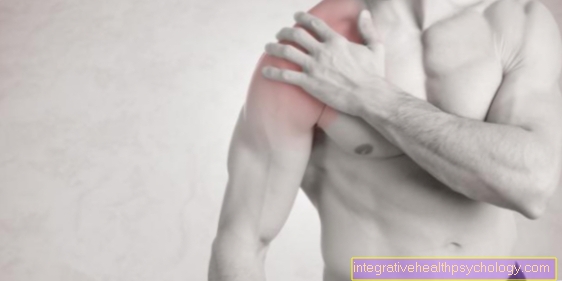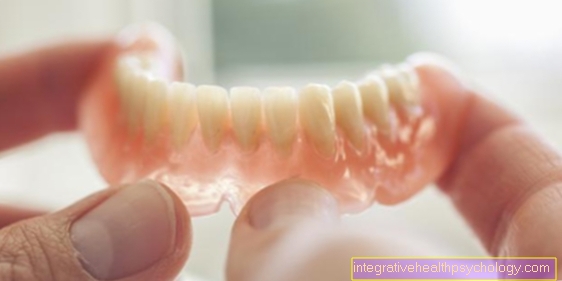Inguinal hernia
introduction
Hernias are "Fractions". Abdominal viscera come out through the abdominal wall. An inguinal hernia is a rupture of the intestines through the inguinal canal. At 75%, inguinal hernias are the most common of all hernias in the human body.
The inguinal canal runs diagonally in the groin: from the back - top - outside to the front - bottom - center. In its course it has to go through several layers of the abdominal wall. Its beginning lies on the inner, its end on the outer inguinal ring. In men, the spermatic cord runs through the inguinal canal.
There are direct and indirect hernias. They differ in their hernial port. The majority (60-70%) are indirect breaks.
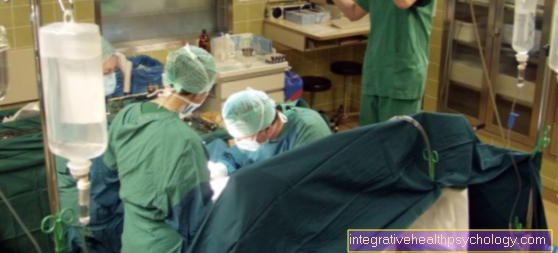
Indirect inguinal hernia
This type of inguinal hernia can be congenital or acquired. In the case of congenital fractures, there is an unlocked layer of the Abdominal wall before after the Testicles has descended as part of normal development in the womb. In the case of acquired fractures, a layer of the abdominal wall only expands in the course of life. The peritoneum also protrudes into the hernial canal.
The indirect one Inguinal hernia always leads through the physiological inguinal canal and can reach into the testicles.
Direct inguinal hernia
In contrast to indirect hernias, direct hernias are always acquired. The hernial orifice has primarily nothing to do with the inguinal canal. It lies further in the middle and the hernial portal runs vertically through the abdominal wall. There are weak points in the muscles here.
Symptoms of an inguinal hernia
The most common symptoms are
- pulling pains, e.g. intensify when coughing intensify
- Swelling, which can sometimes be reduced back into the abdomen by external pressure
- Feeling of pressure
- referred pain in the thigh or genitals (for example, a pulling in the testicle)
Learn more at: Symptoms of an inguinal hernia
Inguinal hernia is also one of the most common causes of inguinal ligament pain. Read more about this at: Inguinal ligament pain
therapy
As a rule, inguinal hernias always require surgical treatment. All operations have in common that the incision is just above the inguinal canal, the hernia is repositioned back into the abdominal cavity and the hernial sac is removed. There are different methods of closing the hernial openings. Laparoscopic procedures are also used.
Surgery for an inguinal hernia
Inguinal hernias are among the most frequently surgically treated diseases in Germany. They are usually treated surgically, as conservative (i.e. non-surgical) treatment does not promise long-term success. The surgery usually takes between 20 and 30 minutes.
In the case of an uncomplicated inguinal hernia, the time of operation can be freely determined by the patient. The exception is the pinched (incarcerated) inguinal hernia, which is an emergency indication; an operation must be performed here as quickly as possible to prevent intestinal tissue from dying off (necrosis).
If general anesthesia is not required, the operation is usually carried out under local anesthesia, so the patient is awake during the operation, but his pain sensation is switched off in the region concerned.
Nowadays there are numerous surgical procedures for treating an inguinal hernia. The goal is largely the same for all of them, namely first to push the contents of the hernial sac back to its actual location (repositioning) and then to strengthen the posterior wall (fascia transversalis) of the inguinal canal. A distinction is made between open surgical procedures in which a skin incision is made and minimally invasive / laparoscopic procedures (keyhole technique), in which very small skin incisions are used.
In the open surgical procedure, some work exclusively with a suture, while others lead to the closure of the hernial opening and reinforcement of the posterior wall by inserting plastic nets. Here the hernia is covered by an 8x12 cm plastic net. There are two differences in the minimally invasive procedure: the transabdominal mesh plastic (TAPP) (see below) and the totally extraperitoneal mesh plastic (TEP). A plastic net is inserted in both procedures.
In TEP, the mesh is inserted by mirroring the peritoneum, so the abdominal cavity does not have to be opened. In addition, there is no need for seams or clips, as the net is held in place by the internal pressure of the abdomen and the counter-pressure of the muscles. The disadvantage of the minimally invasive versus the open procedure is that they require general anesthesia.
Read on below: How do you operate on an inguinal hernia?
What is the Lichtenstein OP?
The Lichtenstein operation is one of the most common procedures for treating an inguinal hernia. It is a small open operation, in which, in contrast to the minimally invasive interventions, the operating area is opened by an approx. Five to ten cm incision in the groin.
The specialty of the Lichtenstein surgical procedure is that the hernial port is closed by inserting a small plastic net. This is sewn to the inguinal ligament and the abdominal muscles so that it cannot slip. The built-in mesh remains in the body and does not have to be removed if the healing process is uncomplicated.
In the Lichtenstein operation, only a local anesthetic is usually required. Since general anesthesia is usually not necessary, the Lichtenstein operation to repair an inguinal hernia in otherwise healthy patients can often be performed on an outpatient basis.
If it is a recurring inguinal hernia that has already been operated on (Relapse), a network should always be installed, for example. According to Lichtenstein, this can then be done as an open procedure or minimally invasive.
Can you operate on an outpatient basis?
In the case of an inguinal hernia, only a small operation is often necessary, which in some cases can also be performed on an outpatient basis. This is especially true for younger and otherwise healthy patients. In principle, outpatient surgery is an option for open surgery, as in contrast to the minimally invasive (“keyhole technique”) procedure, general anesthesia is often not required.
The attending physician and the patient must therefore decide whether an outpatient operation is an option, taking all the factors together. If there are reasons against outpatient care, the procedure can often be carried out with a short inpatient stay of two days.
TAPP - operational sequence
The TAPP is a surgical procedure for the treatment of inguinal hernias. It is one of the minimally invasive / laparoscopic procedures, so it is operated using the keyhole technique.
The aim is to strengthen the rear wall of the inguinal canal by inserting a plastic mesh. Nowadays, the TAPP procedure is mainly used for recurrent hernias (i.e. recurrent hernias that were previously surgically treated) and for bilateral hernias.
The operation is performed in a supine position and under general anesthesia (intubation anesthesia).
- It begins with making an approximately 1 cm long skin incision in the area of the navel. An instrument is inserted through this and gas is introduced into the abdominal cavity. This is necessary so that the surgeon has a sufficiently good view of the operating area.
- A camera is then introduced through the existing incision, and an additional instrument is introduced through a small skin incision on both sides of the abdominal wall.
- Now the content of the hernial sac is carefully repositioned, i.e. relocated back to where it belongs. After dissecting the peritoneum, the surgeon arrives at the inguinal canal. Here the plastic net is inserted, placed over the hernial opening and fixed with a few clamps.
- Most of the gas is released from the abdominal cavity and the opened peritoneum is closed again with staples or sutures.
- The instruments are now pulled out and the small skin incisions are sutured after the remaining gas has been released. This completes the operation.
TAPP - complications
Complications are rare, but the patient must be informed of the possibility of their occurrence before any procedure. This can lead to injuries, constriction or irritation of nerves in the groin area.
As with any surgical procedure, complications can arise during the operation. The most common are:
- Injury to the spermatic cord, intestine and bladder
- Injury to the vessels
- Injury to nerves
- Secondary bleeding
- Wound healing disorders
- Thrombosis with subsequent pulmonary embolism
- Disorders in the area of the testicle, e.g. in the form of swelling or atrophy
- Nausea, vomiting, and stomach and shoulder pain
- reduced bowel activity
- Recurrences (recurrence of an inguinal hernia)
- Infections
- chronic groin pain
TAPP - After the operation
Inguinal hernia surgery can be performed as an outpatient procedure, which means that the patient can be discharged home on the same day. Of course, this depends on the overall condition of the patient and the type of surgical procedure.
After the operation, heavy physical exertion such as lifting of loads can be avoided. Here, too, the exact behavioral guidelines depend on the surgical procedure.
If pain management is needed, it is usually done with non-steroidal anti-inflammatory drugs such as ibuprofen. For thrombosis prophylaxis, Herapin should be used until full mobilization is achieved.
This mobilization should be done as quickly as possible, but adapted to the pain. You can eat normally immediately after the operation, depending on the patient's wishes. A sick leave of 1-2 weeks is the rule.
You might also be interested in: Pain after surgery
Can an inguinal hernia also heal on its own?
In most cases, if an inguinal hernia is found, it should be operated on promptly. Studies have shown that the attempt to heal an inguinal hernia by itself (conservative approach) usually fails.
In the past, for example, an externally applied inguinal ligament was used with the aim of the hernia growing on its own. However, it has been shown that the fracture continues to enlarge. In addition, parts of the intestine can become trapped in the hernial opening, which results in a life-threatening intestinal obstruction.
If a patient with an inguinal hernia still refuses an operation, they should at least undergo regular examinations.
forecast
Depending on the surgical method, inguinal hernias occur repeatedly in 2-10% of cases. The lowest recurrence rate is with the procedure after Shouldice and at laparoscopic Techniques recorded. If an inguinal hernia occurs again, which has already been operated on, the re-operation is much more difficult. Implants can also be necessary to close the hernial opening.
In order to avoid fractures, lifting should not be difficult, especially after an inguinal hernia operation. Strong abdominal wall muscles are a prerequisite for avoiding the acquired hernia.
Causes of an inguinal hernia
The main cause of acquired hernias is weak abdominal wall muscles. The inguinal hernias are usually caused by lifting too heavily. In the case of congenital inguinal hernias, a layer of the abdominal wall was not completely closed after descent of the testicles (the testicle is initially animate in the body and descends into the scrotum until birth).
In the normal development of the male fetus, the testicles arise in the abdomen and only descend over time through the abdominal wall and the inguinal canal into the scrotum.
You might also be interested in: These are the causes of an inguinal hernia
Differences between men and women
An inguinal hernia (hernia) can affect both men and women. Due to gender-specific differences in the anatomical structure and the structures that run through the inguinal canal, the types of fracture differed in their frequency and type.
In general, men are eight to nine times more likely to have an inguinal hernia than women. This is because as the male body develops, the testicles migrate from the abdomen via the inguinal canal into the scrotum. The inguinal canal can thus represent a natural weak point in the abdomen.
In men, with an inguinal hernia, the contents of the hernia (for example a loop of intestine) can penetrate into the scrotum. It is then a so-called Testicular hernia. In women, parts of the intestine or an ovary may penetrate through the inguinal canal to within the outer labia, which is comparatively very rare.
Read more on the topic: Testicular hernia
Special gender-related risk factors for an inguinal hernia in women are pregnancy and in men an enlarged prostate. A possible complication of an inguinal hernia that only affects men is erectile dysfunction (erectile dysfunction) if nerves that pull into the genital area are damaged by the break. The treatment and surgical options do not differ between the sexes, however.
Please also read our topic: Inguinal hernia of the woman
Can you prevent an inguinal hernia?
An inguinal hernia can be prevented to a certain extent through a healthy lifestyle. Regular physical activity and a balanced diet contribute to the stability of the abdominal wall (muscles and connective tissue). This can protect against a hernia. Inguinal hernias are often caused by excessive or improper physical stress.
In order to prevent an inguinal hernia from occurring, it is therefore important not to lift too heavily if possible. Especially sudden heavy loads, such as when lifting a heavy object quickly, carry the risk of provoking an inguinal hernia. You should therefore always proceed slowly when lifting, use aids or carry the load with several people.
Despite the preventive measures mentioned, many people (especially men) suffer from a hernia in the course of their lives. It is crucial that new symptoms such as swelling and pulling in the groin be examined by a doctor as soon as possible. The faster the hernia is identified and treated, the better the chances of recovery.
Sick leave with an inguinal hernia
The length of the sick leave depends on various factors. First of all, it is crucial whether an operation is carried out and if so, when. The minimum period of sick leave is two days. After more complex operations or delayed healing, the inability to work can also be certified for more than two weeks.
In addition, the appropriate sick leave depends on what the patient is doing. While a mainly mental and sedentary activity can be resumed more quickly, a person who mainly works physically has to be on sick leave longer.
Diagnosing an inguinal hernia
The clinical examination cannot be replaced by any other diagnosis. The hernia should be palpated (Also make the patient cough), the repositionability can be tested. An inguinal hernia can be reduced if it can be pushed back through the hernial orifice. Furthermore, only ultrasound can be used as a supplementary measure to assess the hernial orifice and the contents of the hernia.
Summary
Inguinal hernias the most common hernias. Men are particularly affected. Inguinal hernias are "fractures", whereby the abdominal viscera emerges through a hernial opening.
Indirect breaks run through the inguinal canal, direct breaks occur straight through the abdominal wall. Swellings and bulges can be seen under the skin, which are palpated to make the diagnosis. As a rule, the fractures can be turned inside out with the fingers, but this is not a therapy and is not permanent. The hernial sac reappears when you cough at the latest.
The symptoms consist mainly of pulling pains in the groin (especially when coughing) and swelling of the affected area. The appropriate therapy is the operation, which moves the contents of the hernia back into the abdominal cavity, removes the hernial sac and sutures it in different ways.
Once a hernia has occurred, there is a high risk of recurrence. Another operation is much more difficult than the first operation.
Recommendations from the editorial team
This might interest you:
- Inguinal hernia
- Symptoms of an inguinal hernia
- How do you operate on an inguinal hernia?
- Inguinal hernia of the woman
- These are the causes of an inguinal hernia





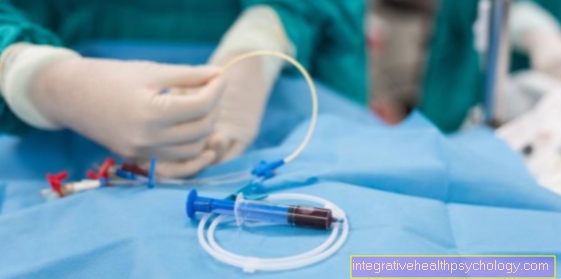
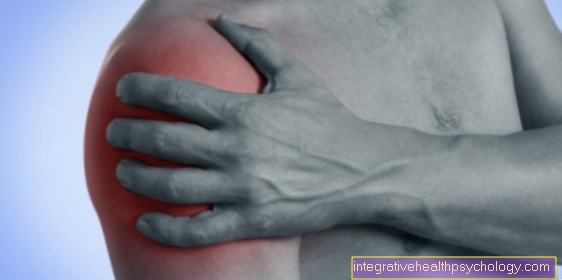



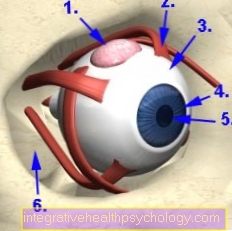
.jpg)


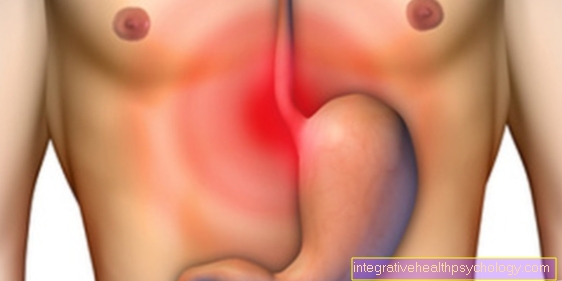


.jpg)




